Gochujang fried rice or Korean Bokkeumbap with kimchi, this spicy rice is addictive!
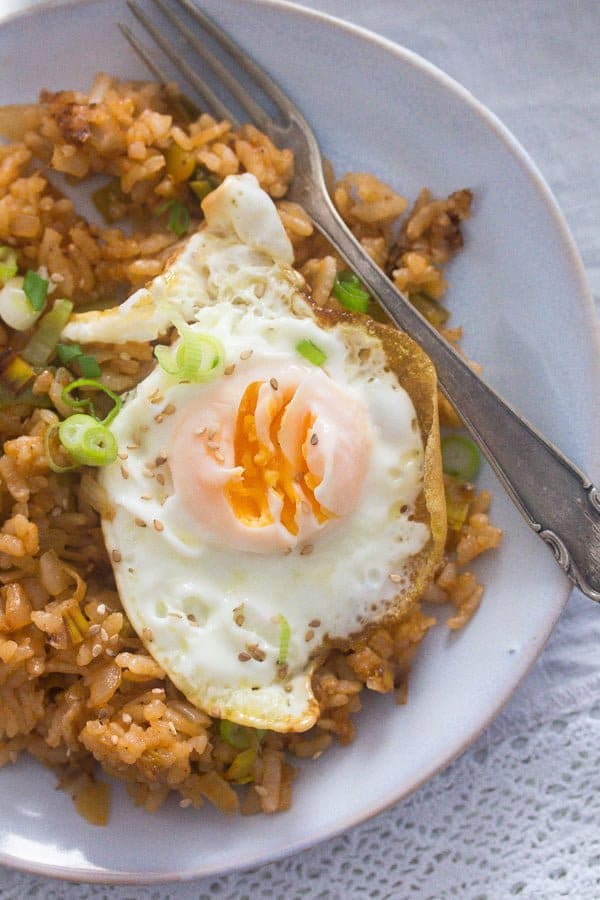
Easy bokkeumbap or Korean fried rice with gochujang paste and kimchi.
I am so much into Korean (and Japanese) food lately, I cannot get enough of it. When it comes to Korean food, it all started with a rather large container of gochujang paste (Amazon affiliate link). I bought it to make some Korean oven-baked chicken wings and I was hooked.
I've made those particular chicken wings several times already, I used it to marinate chicken drumsticks and to make an amazing Korean chicken stew.
And then there is the kimchi… So good! I have to say I can eat it with pretty much anything: as an accompaniment to a hearty stew (even if I cooked a Romanian or German stew that has no hint of anything Korean or Asian in it), I eat kimchi with bread and cheese, with polenta dishes or with meatballs…
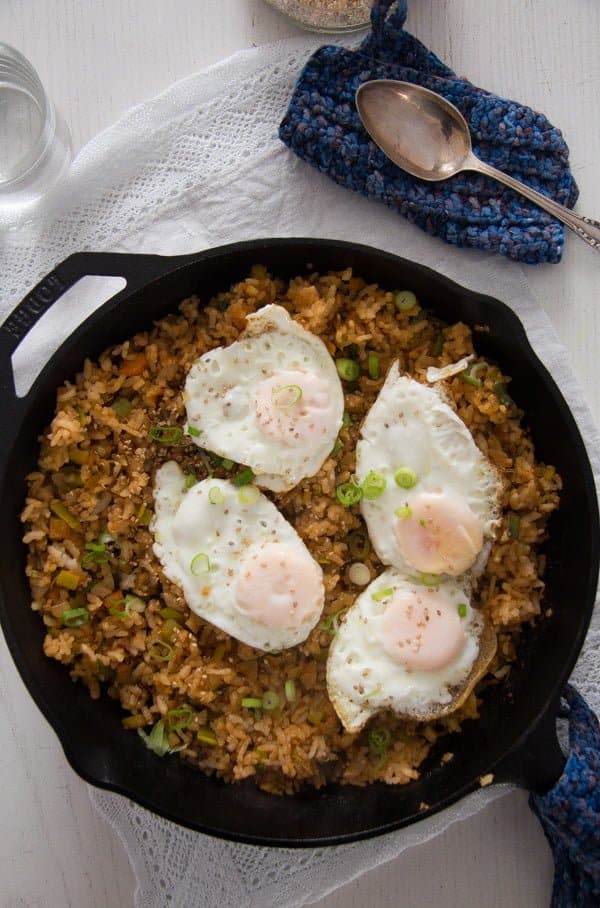
What is gochujang?
- Gochujang paste is a Korean fermented condiment containing chili powder, glutinous rice, fermented soybeans, and salt.
- It comes in several heat degrees, pay attention to that when purchasing gochujang paste.
- My medium gochujang paste is really hot, I always use slightly less than instructed in a recipe.
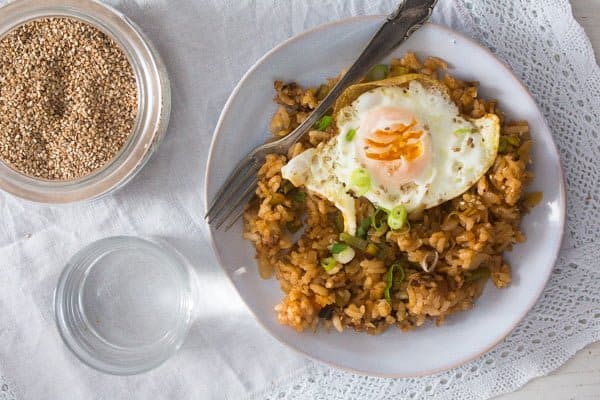
What is kimchi?
- Kimchi is a Korean dish of pickled vegetables. The best-known kind of kimchi in our parts of the world is made with napa cabbage.
- But otherwise, there are dozens and dozens of different kinds of kimchi. You could make it with other vegetables like white cabbage, different sorts of radishes, carrots, cucumber and so on. The kimchi I buy is usually made with white cabbage.
- In order to make kimchi, the vegetables are fermented with lactic acid bacteria and spiced with Korean red pepper gochugaru.
- Korean kimchi is full of nutrients and healthy microbes.
- The fermentation with the lactic acid bacteria is a natural process in which the bacteria feed on the sugar and starch in the food, creating the lactic acid and thus preserving the food.
- This natural fermentation preserves the nutrients in the vegetables and also makes them more digestible. The probiotics (good live bacteria and yeasts) are also formed during the fermentation process. This good bacteria helps improve digestion, boosts immunity, and helps us maintain a healthy weight.
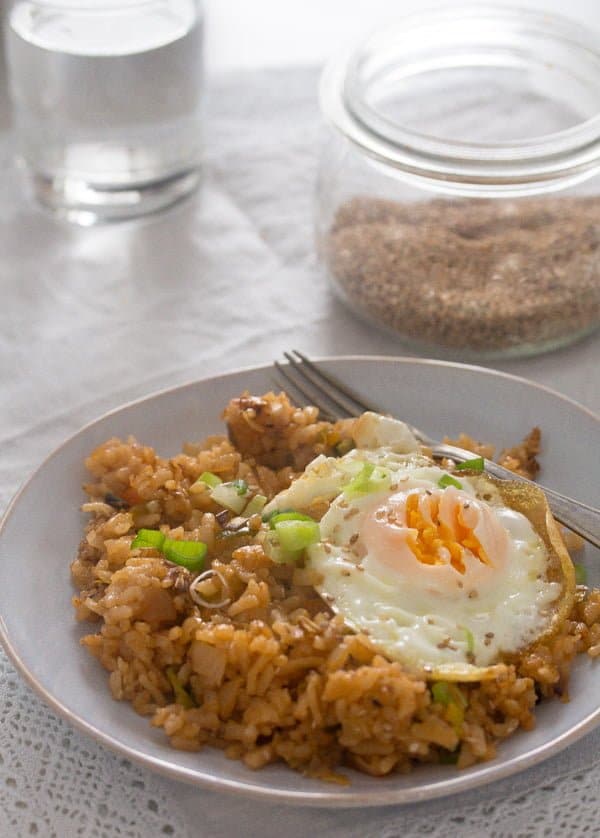
How to make gochujang fried rice?
Cook rice or use leftovers:
- The rice has to be cooked and cooled already. Rice leftovers can be used instead.
- The best kind to use for Korean bokkeumbap is short-grain white rice. But if I happen to have basmati or plain rice leftovers I would use those as well. The consistency will be a bit different, but the dish will be equally delicious.
- It needs to be cooked in advance, ideally the day before, but you could also cook it on the day you are cooking and leave it until completely cool.
Cook kimchi and vegetables:
- Chop the kimchi, leek, and green bell pepper.
- Heat 1 tablespoon oil in a large cast-iron skillet or nonstick pan over high heat. Add the kimchi, leeks, green pepper, and scallion whites and stir-fry for about 3 minutes.
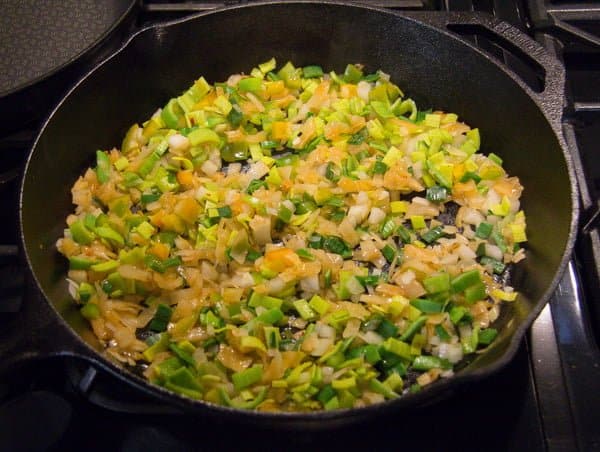
- Whisk together the kimchi juice, gochujang paste, and soy sauce in a small bowl. Add the mixture to the skillet together with the cooked rice.
- Mix well to combine and fry on medium-low heat for about 3-5 minutes or until the rice is hot. Stir in the sesame seed oil and remove it from the heat.
- Use gochujang paste to taste, I have seen recipes using 2 or 3 tablespoons of the paste, but that is definitely too hot for us. I added one tablespoon gochujang sauce to our kimchi fried rice and found that perfect. You could start with about ¾ tablespoon and add more to taste.
- I like adding a small amount of roasted sesame seed oil to many Asian dishes I cook at home. It is not mandatory, you should not buy it just for one dish, but if you have it or plan to cook more Asian food during the next months, then do get a small bottle of it.
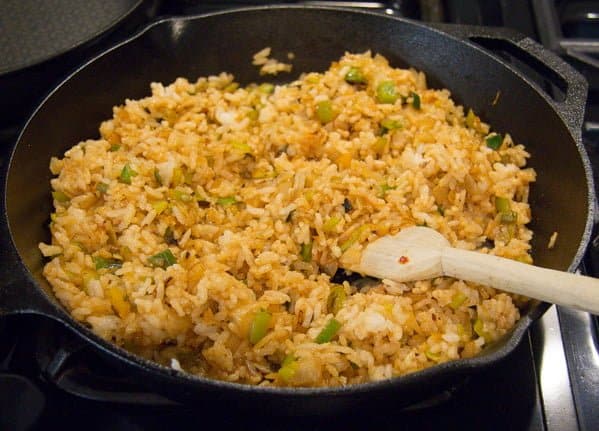
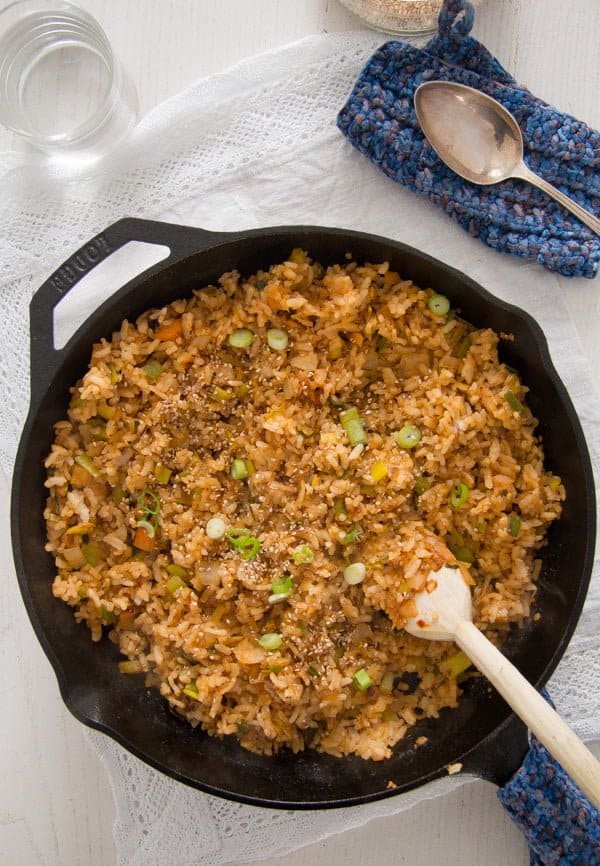
Garnishing and serving
- I also add some roasted sesame seeds on top of the finished Gochujang fried rice, they are almost a must for any Korean dish I happen to cook lately.
- I serve the dish topped with fried eggs, one or two per person, you can decide that. You can fry the eggs to your liking, the yolk can be runny or set. The egg yolks in the pictures are rather set (kids don't like them runny), but personally I would always go for a runny yolk, I should have taken mine out of the frying pan one minute earlier…
- Sprinkle the kimchi fried rice with the chopped scallion greens and sprinkle some toasted sesame seeds.
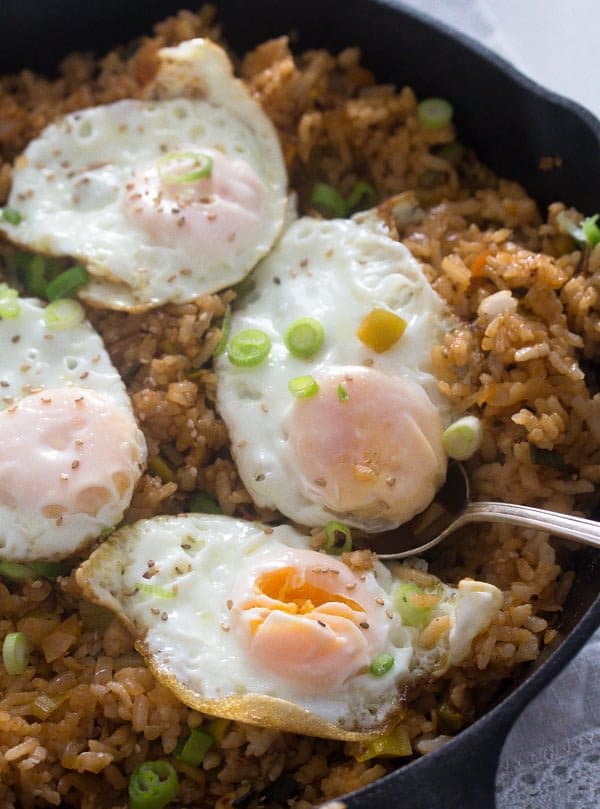
More international rice recipes:
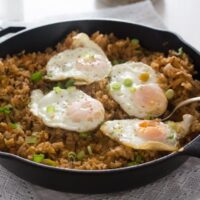
Bokkeumbap - Gochujang Fried Rice
Ingredients
- 300 g/ 10.6 oz/ 1 ⅓ cups uncooked short-grain rice or 600 g/ 1.3 lbs/ about 4 cups cooked rice See note 1
- 2 tablespoons vegetable oil divided
- 250 g/ 8.8 oz/ about 2 ½ cups kimchi
- 1 small leek about 150 g/ 5.3 oz
- ½ green bell pepper
- 3 spring onions/scallions
- 4 tablespoons kimchi juice
- 1 tablespoon gochujang paste See note 2
- 2 tablespoons soy sauce
- 2 teaspoons toasted sesame seed oil
- 1 teaspoon roasted sesame seeds
- 4 eggs
Instructions
- Chop the kimchi, leek and green bell pepper. Chop the whites of the spring onions and leave the greens for garnishing the dish.
- Heat 1 tablespoon oil in a large cast-iron skillet or nonstick pan over high heat. Add the kimchi, leeks, green pepper, and scallion whites and stir-fry for about 3 minutes.
- Whisk together the kimchi juice, gochujang paste and soy sauce in a small bowl. Add the mixture to the skillet together with the cooked rice. Mix well to combine and fry on medium-low heat for about 3-5 minutes or until the rice is hot. Stir in the sesame seed oil and remove from the heat.
- Heat the remaining tablespoon vegetable oil in a large pan. Fry the eggs to your liking.
- Sprinkle the kimchi fried rice with the chopped scallion greens and sprinkle some toasted sesame seeds. Serve immediately with the fried eggs.
Notes
- Ideally, the rice should be cooked one day in advance. If cooking the rice on the same day, make sure it is completely cool before making the kimchi fried rice. 300 g/ 10.6 oz / 1 ⅓ cups uncooked rice yield more or less 600 g/ 1.3 lbs/ about 4 cups cooked rice.
- Start with ¾ tablespoon gochujang paste and increase the amount (up to 3 tablespoons – very hot!) according to your heat tolerance.


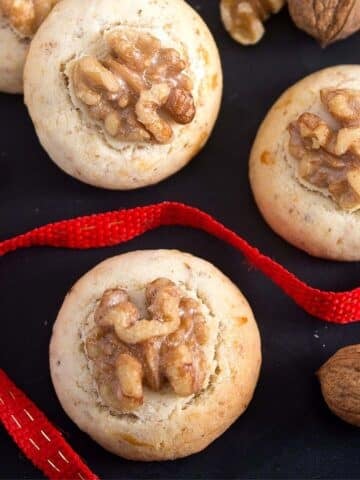
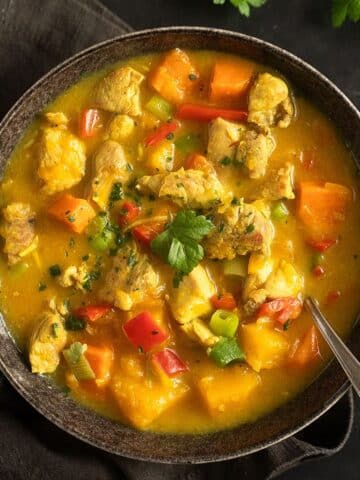

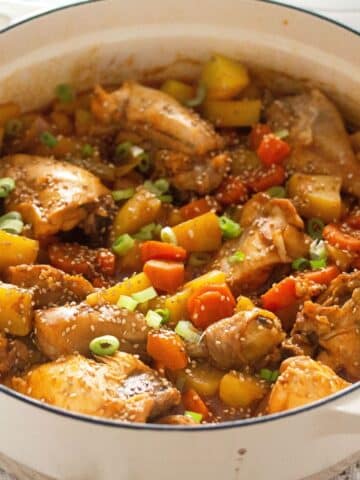

Sissi says
What a nice surprise to see a kimchi-based dish on your blog! I prepare kimchi quite often and love it in warm dishes. I must have now a year-old kimchi in the fridge and look forward to cooking it this weekend! The older the kimchi the better it's in warm cooked dishes! I'm sure you'll make fantastic kimchi as long as you use Korean chilli powder (if I may advise...) but I know it's easy to buy on internet in every European country (this is how I buy it by the way).
Anca says
I'd love to try kimchi, but so far I haven't seen a vegetarian option in shops. The one that I saw had some fish in it. Your dish looks amazing.
Adina says
I have just checked the kimchi I have in the fridge, no fish here. ☺ I would like to make kimchi at home soon, it is probably even better.
angiesrecipes says
It looks like a perfectly healthy and flavourful meal!
Adina says
Thank you, Angie.
Thao @ In Good Flavor says
I guess you really love kimchi! Kimchi, bread and cheese is a pretty interesting combo! I had kimchi regularly as a kid but not as an adult but should incorporate it into my diet now that I'm older and could benefit from its healthful qualities. This fried rice looks delicious and flavorful! The eggs on top is a perfect finish!
Adina says
In Romania we eat fermented vegetables with just about anything, that's why bread and cheese is normal for me. Romanian pickles are not spicy at all, but it doesn't matter if they are only sour or spicy and and sour, love them all. 🙂 🙂
Karen (Back Road Journal) says
While I don't care for kimchi that much(I like other pickled veggies though), my husband loves it and would certainly be happy with your dish. 😀
Adina says
I think your husband will like it, Karen, my husband loved it too and he's not the greatest pickles fan. 🙂